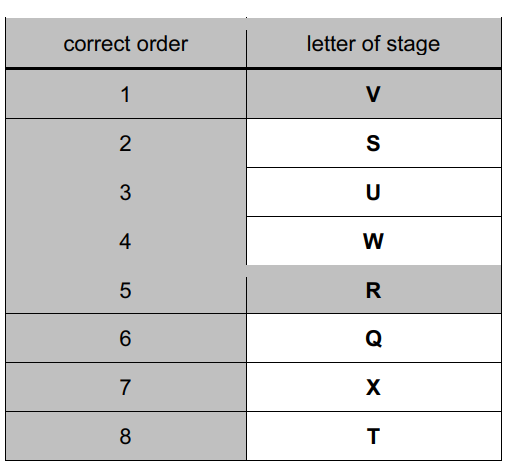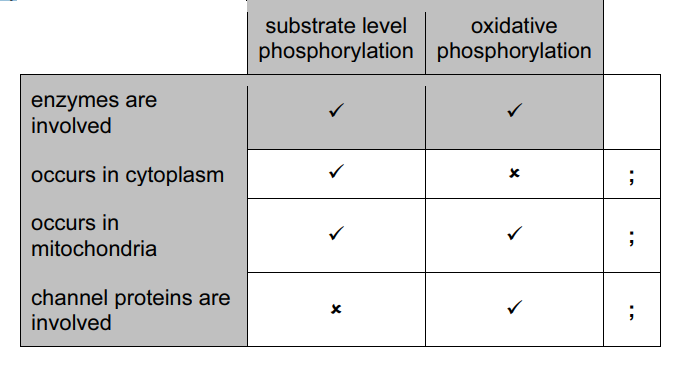Question
(a) A mitochondrion contains DNA and ribosomes and is the organelle in which aerobic respiration takes place.
Suggest the functions of the DNA and ribosomes in a mitochondrion.[3]
(b) Oxidative phosphorylation takes place in the mitochondrion.
Different stages of oxidative phosphorylation are listed below.
They are not listed in the correct order.

Complete Table 8.1 to show the correct order of the stages.
Two of the stages have been done for you.[4]

(c) ATP can be converted to ADP and inorganic phosphate by the enzyme ATPase.
State the type of reaction taking place.[1]
(d) Some parasitic worms, such as tapeworms, live in a mammalian gut where there is no oxygen.
Suggest how a tapeworm produces ATP in this environment.[5] [Total: 13]
Answer/Explanation
Ans:
8 (a) (DNA for) transcription/ codes for mRNA ;
(ribosomes for) translation ;
synthesis of, respiratory enzymes / named enzyme/ inner membrane proteins ;
(b) 
S U W all above R ;
S U W in correct order ;
Q X T all below R ;
Q X T in correct order ;
(c) hydrolysis / dephosphorylation/ exothermic / exergonic ;
(d) anaerobic respiration ;
substrate level phosphorylation (in glycolysis);
at triose phosphate → pyruvate step ;
(net) gain of 2ATP (per glucose) ; A 2 used and 4 produced
pyruvate, reduced/ gains hydrogens (from reduced NAD) ;
forming lactate ;
NAD regenerated/NADH2 re-oxidised ;
this allows glycolysis to continue ; I ethanol pathway
Question
(a) Fig. 5.1 shows the structure of an ATP molecule.

State two ways in which the structure of ATP differs from the structure of an adenine nucleotide in a DNA molecule.[2]
1
2
(b) In respiration, energy from various substrates is used to synthesise ATP.
(i) Explain why less ATP can be synthesised from the same mass of glucose in anaerobic respiration than in aerobic respiration.[3]
(ii) Explain why more ATP can be synthesised in aerobic respiration from one gram of lipid than from one gram of glucose.[3] [Total: 8]
Answer/Explanation
Ans:
5 (a) contains ribose (not deoxyribose) ;
has three phosphate groups (not one) ;
(b) (i) anaerobic – accept ora for aerobic
1 idea that glucose not completely, broken down/oxidised
or
only glycolysis occurs ;
2 pyruvate/lactate/ethanol, still contains energy ;
3 ETC stops ;
4 (because) no oxygen to act as (final) electron acceptor ;
5 (so) no, Krebs cycle/link reaction/oxidative phosphorylation/ chemiosmosis ;
(ii) 1 lipid contains (relatively) more, hydrogen atoms/C-H ;
2 detail ; e.g. molecular formula of glucose and a lipid given
3 more reduced, NAD/FAD, produced ;
4 more electrons passed along ETC ;
5 more hydrogen ions pumped across inner mitochondrial membrane/ more hydrogen ions pumped into intermembrane space/ steeper proton gradient ;
Question
(a) Outline the process of glycolysis in a mammalian cell. [6]
(b) Within a mammalian cell, ATP can be produced in a number of ways, including:
- substrate level phosphorylation during the Krebs cycle
- oxidative phosphorylation.
Table 7.1 compares both processes.
Complete Table 7.1.
Use a tick (check) if the statement is correct or a cross (×) if the statement is incorrect. The first row has been done for you.[3]

(c) An investigation into the RQ values of germinating maize seeds was carried out.
- A sample of maize seeds was soaked in water for one hour.
- The mean RQ value of some of the seeds was then calculated and the remaining seeds were then planted in soil.
- After 12 hours, the mean RQ value of some of the planted seeds was calculated.
- The remaining seeds were allowed to germinate and grow into seedlings.
- After 21 days, the mean RQ value of some of the seedlings was calculated.
Table 7.2 shows the results of the investigation.

Suggest an explanation for each of the RQ values shown in Table 7.2.[6]
seeds soaked in water
seeds after 12 hours in the soil
seedlings after 21 days
[Total: 15]
Answer/Explanation
Ans:
7 (a) 1 glucose phosphorylated by ATP ;
2 (forms) hexose/fructose, bisphosphate ;
3 raises energy level of/ activates, glucose/ sugar
OR
lowers activation energy of reaction ;
4 breaks down to two TP ;
5 6C → 2 × 3C ;
6 hydrogen (atoms) removed/ dehydrogenated/ oxidised ;
7 2 reduced NAD formed ; A NADH/NADH2
8 ref. to 4 ATP produced/ net gain of 2 ATP ;
9 pyruvate produced ;
10 AVP ; e.g. ref. to substrate level phosphorylation/ dehydrogenase / phosphofructokinase/hexokinase
(b)

(c) seeds soaked in water
1 little/ no, oxygen (in water) ;
2 (mostly) anaerobic respiration ;
seeds after 12 hours in the soil
3 (more) aerobic respiration/ less anaerobic respiration ;
4 mixture of substrates ; e.g. 2 of carbohydrates, proteins and lipids
seedlings after 21 days
5 aerobic respiration ;
6 substrate is, glucose/ carbohydrate ;
7 ref. to presence of leaves /photosynthesis ;
